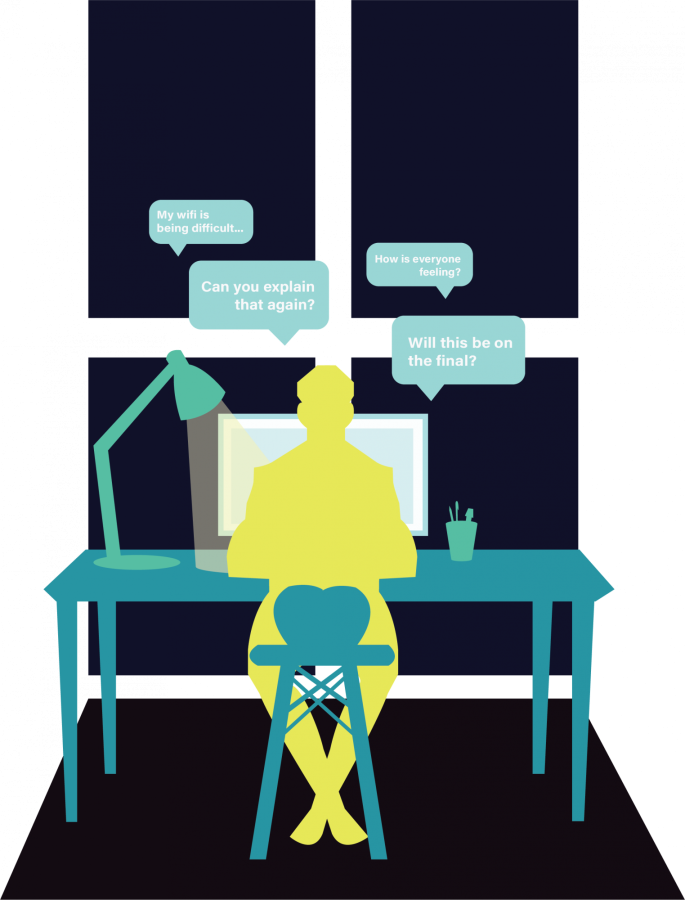Although students really felt the pressure during this confusing semester, professors across the country were tasked with the job of converting their entire syllabus to fit an online format while still keeping students engaged.
It wasn’t an easy transition, but professors intensely dedicated to the education of their students at home and abroad found ways to curve the strangeness of online instruction.
University of Arizona economics professor Dirk Mateer is teaching two sections of ECON 200, which caters to about 1,000 students. Mateer said he had never taught an online class before now, but he has experience with designing online classes.
For the amount of students that Mateer teaches, Zoom seemed “too unwieldy.” So, he decided to take his class to powerpoint presentations and make slight alterations to ease the readability. He animated the slides and added call out boxes in them.
Mateer said to keep his class engaged, he kept one portion of the class that students enjoyed when the class was in-person — playing Kahoot! challenges.
But through all the alterations, Mateer emphasized one aspect of the class that could not really be replaced: the in-person contact.
“I love the feedback when we meet face-to-face,” Mateer said in an email. “I missed the contact with the students and I think they missed it as well.”
RELATED: Students spark Club Penguin resurgence during COVID-19
Despite all of the confusion that this semester brought, he said he feels hopeful not only for the fall semester, but for life in general. Mateer found “Hope” within the chaos.
“Our daughter, Hope, was born six weeks early on April 28th,” Mateer said in an email. “All of the Covid craziness goes away when you get to see and hold a tiny human.”
Natalie Amgott, a graduate student teaching French 202, said although she knew the decision to make classes online was “wise,” she still knew how it could affect both instructors and students mentally.
Amgott preserved the overall structure of the class by holding Zoom sessions at regular class times. However, she still had to make some alterations to the syllabus.
“We went through the rest of the syllabus and curriculum for the semester and cut and modified some so that the focus would be on quality of content, instruction, and community-building, rather than on quantity of material,” Amgott said in an email.
When it came to keeping her students sane, Amgott went the extra mile. In addition to these alterations, Amgott integrated mental health check-ins to her class. She asks students to talk about how they are doing in English or French, asks them to use Zoom reactions, checks in with students individually and includes an extra question at the end of French grammar quizzes that reads, “How are you doing? How am I doing? How can I help you succeed?”
RELATED: University of Arizona organization adapts to being online
For Amgott, seeing her students during Zoom calls is still the “best part of the day.” Although she has tried to remain hopeful, she said that teaching a language in an online format is still difficult.
“Despite my research in technology and my experience teaching online, I want to highlight that face-to-face classes cannot simply be transferred to online learning in one fell swoop,” Amgott said in an email.
Slide shows and Kahoot! quizzes worked fine for Mateer’s ECON 202, but for language classes that rely on classroom engagement, a separate set of issues arises.
Amgott explained that the French 202 curriculum was molded around face-to-face communication and collaboration. It is difficult to learn a language conversationally without seeing others in person.
“I really miss seeing my students in person, though, and there is no replacement for that. Ultimately, language learning is about community,” Amgott said in an email.
With the spring semester coming to an end, students and faculty at the UA will have an interesting university experience under their belts.
Follow Isabella Barron on Twitter















